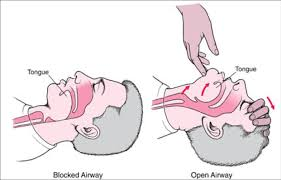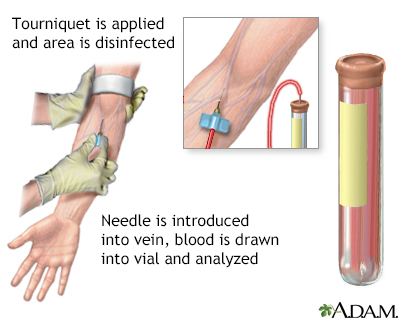A patient suspected of having a severe medication reaction goes into shock. Which of the following first aid measures should the phlebotomist take?
Keep the patient as upright as possible.
Provide a cooling blanket.
Administer oral fluids.
Maintain an open airway.
The Correct Answer is D
Choice A Reason:
Keeping the patient as upright as possible is not recommended in cases of shock. When a patient is in shock, it is important to lay them down and elevate their legs slightly, unless this position causes pain or further injury. This position helps improve blood flow to the brain.
Choice B Reason:
Providing a cooling blanket is not a standard first aid measure for shock due to a medication reaction. A cooling blanket may be used in cases of hyperthermia or heatstroke to reduce body temperature, but not typically for shock, which requires maintaining normal body temperature and preventing chilling.
Choice C Reason:
Administering oral fluids to a patient in shock is not advisable. During shock, a patient may have an impaired swallowing reflex or be unconscious, increasing the risk of aspiration. It is best to avoid giving anything by mouth until medical personnel arrive.
Choice D Reason:
Maintaining an open airway is crucial for a patient in shock. Ensuring that the airway is clear allows the patient to breathe effectively, which is essential for delivering oxygen to the tissues and organs. If the patient is unconscious or has an altered level of consciousness, the phlebotomist should check for breathing and begin CPR if necessary.

Nursing Test Bank
Naxlex Comprehensive Predictor Exams
Related Questions
Correct Answer is C
Explanation
Choice A reason:
Simply observing the site to see if the hematoma worsens is not an appropriate response. While monitoring the development of a hematoma is part of the process, it is not a proactive measure to address the immediate issue. The phlebotomist must take action to prevent further injury or complication.
Choice B reason:
Asking the patient to apply pressure may be part of the post-venipuncture care, especially after the needle has been removed, to aid in stopping any bleeding. However, this does not address the immediate concern of a developing hematoma during the draw.
Choice C reason:
Releasing the tourniquet and stopping the draw is the correct action to take when a hematoma is observed. This response is in line with the standard procedure for when a complication arises during venipuncture. Stopping the draw helps prevent further blood from pooling and exacerbating the hematoma.
Choice D reason:
While calling for a nurse and assessing the patient's condition is important, especially if the phlebotomist needs assistance or the patient shows signs of distress, it should not be the first action taken. The immediate response should be to address the hematoma by stopping the draw.

Correct Answer is A
Explanation
Choice A reason:
Asking another phlebotomist to obtain the specimen is a prudent step after multiple unsuccessful attempts. It can reduce the patient's discomfort and anxiety. A fresh perspective from another professional might increase the chances of a successful draw, especially in challenging situations like small, fragile veins often found in diabetic patients.
Choice B reason:
Performing the draw on a foot is not typically recommended due to the increased risk of infection and complications, especially in diabetic patients who may have reduced sensation and slower healing in their extremities. This option should only be considered when other more proximal sites have been deemed unsuitable.
Choice C reason:
Repeating the draws until successful is not advisable as it can cause undue stress to the patient and increase the risk of hematoma or vein damage. It is essential to minimize the number of attempts to prevent patient discomfort and potential complications.
Choice D reason:
Performing the draw on a leg is another option that is generally avoided unless absolutely necessary, due to similar reasons as drawing from a foot—risk of infection and complications. Additionally, it can be an uncomfortable position for the patient.
Whether you are a student looking to ace your exams or a practicing nurse seeking to enhance your expertise , our nursing education contents will empower you with the confidence and competence to make a difference in the lives of patients and become a respected leader in the healthcare field.
Visit Naxlex, invest in your future and unlock endless possibilities with our unparalleled nursing education contents today
Report Wrong Answer on the Current Question
Do you disagree with the answer? If yes, what is your expected answer? Explain.
Kindly be descriptive with the issue you are facing.
